How to change the sewer riser in the apartment
Today many houses have old cast iron risers. This material is not eternal, and over time it wears out and requires replacement. Before starting this work, it is necessary to warn neighbors with whom you have one common riser, and for the period of repair turn off the hot and cold water supply with valves located in the basement.
Dismantling the old riser
Since the material of the old riser is cast iron, the work on dismantling it should be carried out with extreme caution. Such a pipe is a rather fragile product, so the blows of a tool can cause the cast iron to crack and even break in the most inappropriate place. First of all, this applies to the site, which is not in its own territory, but in the overlap between the floors. In this hard-to-reach place, as a rule, a tee is mounted, the material of which is also cast iron.
Tip! To split the iron, no need to make special efforts. If this happens, you will have to invest and work much more than was expected before the repair.
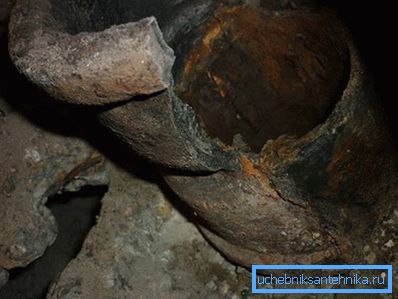
At the initial stage of dismantling, you need to cut a cast-iron pipe of a certain length. This work is carried out in the following sequence:
- At a distance of 80 cm from the floor with a grinder or hacksaw, an incision is made in the horizontal direction. It is advisable to make it around the entire diameter contour, but since the cast-iron pipe is located against the wall, it is necessary to make the maximum possible incision.
- A similar incision is made on the riser near the ceiling. The distance from the tee socket, located in the upper floor, to the notch should be about 15 cm.
- Then the hammer and chisel are used. Work begins with a lower notch into which a sharp tool is inserted. The chisel must be tapped gently with a hammer, while the tool to be struck must gradually move along the circumference. As a result, the riser will burst exactly at the intended incision.
- After that, the turn comes to the top notch. Similar manipulations are done with it. After the pipe bursts at the top, the sewer riser is removed.
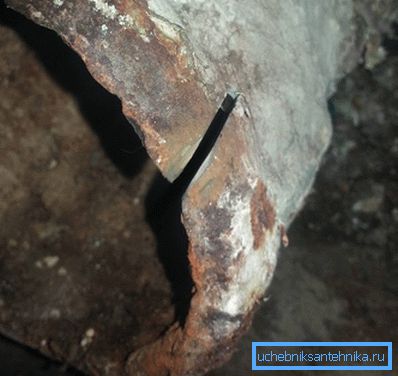
Now, before carrying out installation work, you need to remove the remaining sections of the sewer pipe, which stick out from the tees in the upper and lower parts. They are connected to the shaped parts by stamping the smooth end into the socket. It is sometimes difficult to pull out these sticking out residues, especially if compaction has occurred using sulfur. Work will go faster and easier if chasing was done with a rope.
- The first version of the seal - using a rope. With its help, the chasing of pipe joints is relatively simple and fast, while dismantling the pipe is also not very difficult. First, the remaining piece of the riser need to hands as much as possible loosen and loosen the mount. It is important not to overdo it and not destroy the pipe that is not to be dismantled by your actions. The same result can be achieved with the help of a hammer, which needs to knock on a segment from different sides, while this work must be carried out carefully so that the distribution tee does not burst. After that, the end of the rope is hooked by a screwdriver or other sharp object, and the seal is pulled out from the docking point.
- If chasing took place with the help of sulfur, then the dismantling of a piece of cold water sewer pipe will take a relatively long time, and the working conditions will be quite complicated. The fixing of the smooth end in the socket in this variant is strong enough and it will be necessary to soften the sulfur to remove a piece of the riser. To do this, it must be exposed to high temperature, for example, using a blowtorch. Works in which sulfur is present are considered quite dangerous. This fact was taken into account several decades ago and they abandoned this type of fixation of the connection of cast iron sewer pipes. However, at one time, this type of fastening was used quite widely, so now this type of coinage is often encountered. Flaming the joint should be along the contour of the socket and from time to time loosen the pipe. When the fastener is loosened, you need to remove the pipe piece, and clean the socket from the inside with a chisel - all the remaining sealant should be removed. Make sure that no sulfur pieces fall inside the pipe, as they can completely block it. To do this, insert into it a suitable diameter gag made from the material at hand. To him you need to securely attach the rope, pulling which, it can then be removed from it.
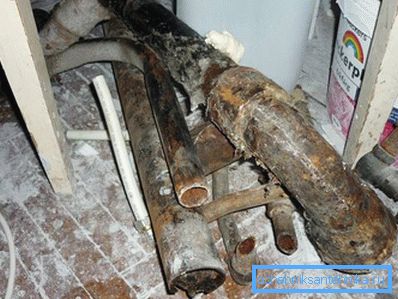
Tip! Sulfur in the hardened state is not dangerous, but at high temperature, which appears under the influence of an open flame of a blowtorch on the pipe joining section, it emits toxic fumes. Therefore, you need to adhere to safety regulations - work in gloves, glasses and a respirator.
Installing a new riser
Once the old cast-iron riser is dismantled, you can install a new one. Since cast iron as a material has not been popular lately, plastic pipes are most often installed. These can be products made of polyethylene, polyvinyl chloride or polypropylene. They well pass both cold, and hot water. If the internal sewer network receives drains from the washing machine or dishwasher, the plastic pipe will work as a hot water riser.
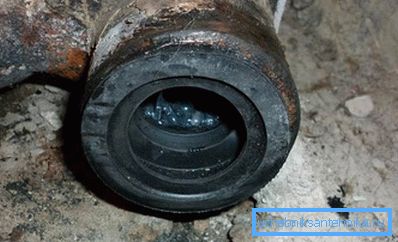
To install, you must perform the following work:
- You need to start with a tee, one end of which comes out of the ceiling. It is necessary to wear a rubber cuff, specifically designed for sealing pipe joints. At the joint itself must be applied sealant.
- A plastic adapter is pulled over the cuff.
- A similar cuff is installed on the lower end of the pipe.
- Then a plastic pipe is measured, which will be a new riser. First, it is mounted from below into the existing riser, after which the plastic pipe is attached to the adapter and the mark is made 5 cm above the edge of the socket.
- After that, the pipe is cut off at the mark and connected to the upper part of the structure. Joints must be treated with silicone sealant.
- Upon completion, the new riser is fixed to the wall with clamps.
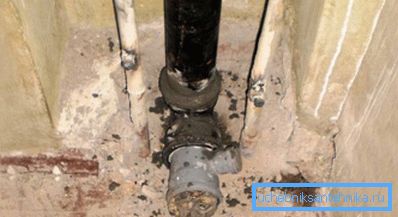
After installing the riser, the valves on the systems of cold and hot water supply open, and water flows through the plumbing fixtures.
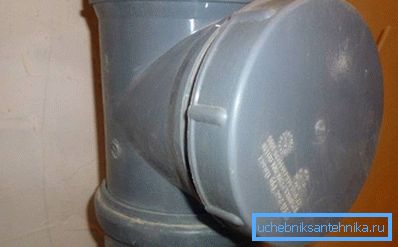
If the riser does not leak, then everything went well, the work was completed, and one household problem became less.